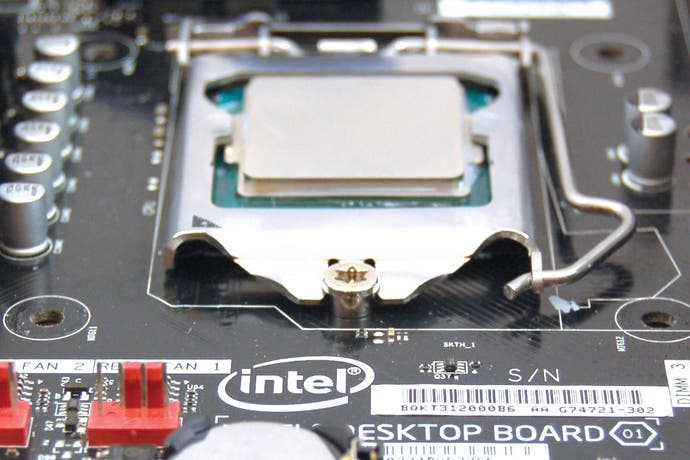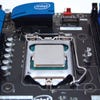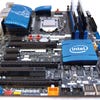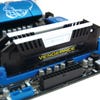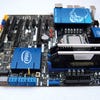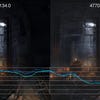Intel Core i7 4770K review
Digital Foundry assesses the gaming prowess of the "Haswell" fourth-gen Core processor.
Intel is facing its biggest challenge in years. Despite dominating the processor market for desktop PCs and laptops, the emergence of the smartphone and tablet has seemingly caught the company by surprise, with only its Atom offerings to keep it in the game. What the firm needs is for its unbeatable Core technology to scale down to tablets and more energy-efficient laptops in order to head off the challenge from ARM. Its new architecture, dubbed "Haswell", is the first step on the journey to making that happen.
But this new CPU design is not just about power efficiency. In the era of tighter integration between CPU and graphics, Intel's exciting solutions have been somewhat lop-sided - market-leading in terms of pure processing but lagging behind when it comes to integrated GPU technology. With Haswell, Intel is looking to share-steal from AMD and Nvidia in the lucrative premium notebook market, by offering a significantly enhanced integrated graphics chip that makes the need for bundling a low or medium-range GPU alongside their excellent processors a thing of the past.
To show the fourth-gen Core at its best, ideally we'd be looking at next-gen ultrabooks, laptops or all-in-one PCs, but the first piece of the Haswell jigsaw we're reviewing is the new Core i7 4770K - an enthusiast-level quad-core processor with hyper-threading that ships with a rated 3.5GHz clock-speed, but happily auto-overclocks itself to 3.9GHz if the processor is put under load. Sounds familiar? Well, its predecessor, the Core i7 3770K, had those exact same clock speeds. Haswell has increased performance per clock, but in its desktop guise, it's not really a game-changer.
In truth, if you're a gamer with a capable dedicated graphics card and you're moving up from the current Ivy Bridge platform, you may come away slightly underwhelmed with what the fourth-gen Core offers. The CPU is leaner and more power-efficient, but there is only a relatively minor bump in performance - in order of five to ten per cent - and in a world where the graphics card takes on so much of the workload, you'll see no radical difference. Games will be incrementally faster and smoother but when the existing Ivy Bridge architecture is so damn fast anyway, the differences will be difficult to pick up on.
Intel hasn't set itself any kind of bold target for generation to generation performance increases for Haswell. Gone are the days of a launch like the first-generation Core (Nehalem) which could see performance in some applications doubled over the outgoing Core 2 Quad. But equally, CPUs used to draw up to 130W from the mains - what we may be losing out on in terms of sheer power is more than made up for by the gains in efficiency. Expectations need to shift from pure performance towards performance per watt - something that's key to Intel's game plan in shifting Core towards mobile applications.
That said, the i7 4770K does offer some clear performance increases over its predecessor, and thus by extension the best mainstream quad-core processor on the market has just got better. This collection of stats allows us to compare the performance of the new chip against its predecessor, plus the gamers' favourite 3570K - effectively a cut-down 3770K, losing hyper-threading along with some cache, and a touch of clock-speed. We've also added in some metrics from the AMD FX-8350 - an eight-core 4.0GHz processor that directly competes with the 3570K in terms of price-point. The tests themselves were carried out with the same components where possible, all with a fully updated Windows 7, with the same programs installed in the same order. The only real difference comes with the FX-8350, which had additional Windows hotfixes installed that ensure that AMD multi-core processors offer best performance.
It's important to point out that the majority of these tests do favour multi-core processing - it's becoming increasingly important in the present and is set to dominate in the future, especially where next-gen gaming is concerned. This does skew the results in favour of AMD to a certain extent, particularly in terms of comparisons with the similarly priced 3570K, but the single-core CineBench score in particular shows just how far behind AMD is on single-thread performance. Unless a PC games engine employs n-way threading - where all threads available are pressed into action - the FX-8350 will lag behind, despite its higher clock-speed. At the moment, when it comes to PC gaming, that's the exception, not the rule.
"Those expecting a large boost in performance over the third-gen Core are likely to be disappointed - the new 4770K offers a boost in the region of five to ten per cent overall compared to the 3770K."
| Intel Core i5 3570K | AMD FX-8350 | Intel Core i7 3770K | Intel Core i7 4770K | Intel Core i7 4770K/4.6GHz | |
|---|---|---|---|---|---|
| 3DMark 11 Physics | 7269 | 7253 | 8708 | 9470 | 9686 |
| 3DMark Physics | 6901 | 7520 | 10105 | 10757 | 12217 |
| CineBench Multi-Core | 5.97 | 6.74 | 7.83 | 8.58 | 10.04 |
| CineBench Single-Core | 1.56 | 1.11 | 1.65 | 1.73 | 2.08 |
| x264 Pass 1 | 52.94FPS | 58.66FPS | 72.23FPS | 77.23FPS | 86.57FPS |
| x264 Pass 2 | 11.98FPS | 14.97FPS | 15.02FPS | 16.92FPS | 19.77FPS |
| Aida64 CPU Queen | 34210 | 35377 | 49310 | 49804 | 58373 |
Speaking of clock-speeds, it's worth pointing out that rated clock-speeds are somewhat conservative compared to what the CPU is actually running at, owing to the turbo boost technology employed by both AMD and Intel. What happens here is that the processor automatically overclocks itself if there is the power budget available. The FX-8350 clocks up to 4.2GHz, while the 3770K and 4770K turbo to 3.9GHz from the "stock" 3.5GHz (the 3570K is slightly slower, hitting a max of 3.8GHz). The Intel chips stayed locked at their turbo frequencies at all times during our intense testing, though we would recommend a good enthusiast cooler to guarantee rock-solid performance.
But these chips offer more of course: overclocking the 4770K was fairly easy with the supplied Z87 Intel board, to the point where we had no stability issues at a max turbo of 4.6GHz. In effect, we got almost 18 per cent worth of extra performance - the cost being increased power consumption. A stock 4770K system drained 100W from the mains at full load, while the 4.6GHz overclock saw that shoot up to 150W.
"Our Haswell sample overclocked nicely to 4.6GHz, but mileage will vary between chips."
Overall, in terms of CPU power, Intel was ahead of the AMD challenge with the 3770K in most benchmarks - but the proximity of the FX-8350 in some applications was perhaps a little uncomfortable, especially bearing in mind that it costs £90 less. The new Haswell successor doesn't see any kind of revelatory increase in performance, but it's clearly a useful bump - and the gap with the FX-8350 has now opened out a little more. Overclocking should be at least on par with Ivy Bridge, and we'd be disappointed if you couldn't get your 4770K easily up to 4.3GHz and beyond, as long as your cooling solution is up to par.
Haswell's GPU upgrade - introducing Intel HD 4600
With Ivy Bridge, Intel bundled Intel HD 4000 graphics with the majority of CPUs in the range and while performance was a significant step up from its predecessor, it still lagged behind the current-generation consoles on most modern games, with demanding titles proving borderline unplayable even on the lowest settings.
As we mentioned earlier, graphics is a considerable focus for Haswell, to the point where the increased power budgets available compared to Ivy Bridge are almost certainly there to give the new integrated GPU room to breathe. However, it's important to clarify that while the 4770K has received improved performance over Intel HD 4000, the product we're reviewing here is far from the best graphics performer in the Haswell line-up. Intel HD 5000 and 5200 - now known as Iris and Iris Pro - are the real stars of the show, but they appear to have been reserved for all-in-one PCs and laptops. Intel correctly believes that the enthusiast market will continue to combine third-party dedicated graphics cards with its own market-leading CPU power, so hasn't spent too much of its silicon budget on in-built GPUs that will rarely see use.
On the one hand, we're disappointed that we couldn't tell you more about the top-line Intel GPU solutions - for now, at least. On the other, the good news is that the new HD 4600 incorporated into the 4770K is quite impressive, offering a quantifiable increase in GPU power that easily propels it beyond current-gen console.
Up against the 3770K's HD 4000, the difference is palpable. Crysis 3 - a ponderous, unpleasant experience (even on the lowest graphical settings) gets enough extra horsepower to run rather nicely at 720p, producing gameplay that's massively more enjoyable than the Xbox 360 or PS3 versions of the game. Similarly, another graphically intensive game - Battlefield 3 - maintains frame-rates well in excess of 720p30 on the medium setting. Moving onto Skyrim, we can now run safely beyond 40FPS on the high setting. There are certain conditions to meeting this level of performance, of course - integrated GPUs lose out heavily on bandwidth since they can only access the DDR3 system RAM as opposed to super-fast GDDR5 found on discrete graphics cards. To mitigate that, in all of our test cases, we've dialled back anti-aliasing in favour of post-process FXAA or the nearest equivalent, and texture filtering gets downgraded to 4x anisotropic.
Despite this, in all cases, the results are still more impressive than what you'll see with multi-platform console equivalents - games are both smoother and prettier. What's more, power draw from the mains for the entire system never exceeds 100W. Indeed, 80-85W was commonplace, bringing a Haswell PC into PS3/Xbox 360 levels of power consumption. Bearing in mind the bump in both CPU and GPU power here, that's impressive stuff.
However, in employing v-sync for our gameplay tests we are limiting the output of the GPU: if a frame is rendered just after the screen refresh, you can be waiting anything up to 16ms for it to appear on-screen, effectively stalling the hardware. Disengaging it might not do too many favours to image quality but it ensures that we're seeing the graphics hardware kept fully occupied.
So in our next round-up of tests, we return to games with in-built benchmarking tools, running them all at 720p on medium settings or the equivalent, being careful to stay well away from MSAA or other bandwidth-hungry graphical features. Our suite of titles consists of Tomb Raider, BioShock Infinite, Sleeping Dogs, Metro 2033 and Hitman: Absolution - games with in-built benchmarking tools that easily allow us to gauge how well the GPU copes with a range of game engines with easily repeatable tests.
Sleeping Dogs proved to be the only disappointment here - factor that out and you're looking at averages of well over 30 per cent in like-for-like improvement across the other games. HD 4000 struggled to match current-gen console in multi-format games, but the new HD 4600 moves significantly beyond it. We aren't looking at enthusiast-level dedicated graphics card power here, but if it runs Crysis 3 you can be sure it'll run just about anything else. On top of that, associated GPU tasks like Intel's video transcoding QuickSync technology will also see big improvements too.
"HD 4600 isn't the best GPU in the Haswell line-up, but it's good enough to run multi-platform games at 720p that look better and offer higher frame-rates than the console equivalents."
| 3770K/HD4000 | 4770K/HD4600 | Perf Boost | |
|---|---|---|---|
| BioShock Infinite | 25.2FPS | 33.3FPS | 23.1 per cent |
| Hitman: Absolution | 23.7FPS | 31.1FPS | 31.2 per cent |
| Sleeping Dogs | 38.9FPS | 43.7FPS | 12.3 per cent |
| Metro 2033 | 29.0FPS | 42.0FPS | 44.8 per cent |
| Tomb Raider | 30.6FPS | 36.9FPS | 20.6 per cent |
Dedicated graphics performance - bring on the GTX 780
Running the Core i7 4770K alongside a dedicated graphics card is probably the most likely scenario for most enthusiast gamers, so we were curious to see how game frame-rates are improved when moving over from Ivy Bridge. Testing this isn't as easy as perhaps you may think. On the one hand, you want to make sure that the testing is not being held back by graphics hardware, but on the other hand, CPU can contribute significantly to effects work, especially at higher detail levels - so the old, time-honoured technique of reducing resolution and graphics settings to the bare minimum and measuring frame-rate from there isn't the best solution.
We opted for a compromise - very high settings at 720p resolution, removing any form of bandwidth intensive anti-aliasing (like multi-sampling AA, for example) from the equation. The idea here is that the CPU still gets a work-out at max settings, but hopefully we won't end up being artificially limited by the GPU. In terms of graphics hardware, we chose the best card at our disposal - the Nvidia GeForce GTX 780. The next challenge is to acquire accurate metrics. Historically, Digital Foundry has relied upon captured video because we trust the output of the PC more than the internals tracked by FRAPS (something PC tech sites are beginning to recognise).
The limitation here is that games running without v-sync can move way beyond the 60Hz sampling we have available. A new tool from Nvidia - called FCAT - removes that limitation, by adding a frame-tracking multi-coloured bar to the left of the screen. This allows us to track multiple images contained within a single frame on-screen. Forget the single tear you see in a console video game running with v-sync disabled - fast PC games running completely unlocked can host sections of five or even more separate frames on-screen at the same time. In our view, it's pretty grim to experience for actual gameplay, but with the engines operating fully unlocked and trackable via FCAT, we can work out theoretical maximums in both CPU and GPU performance. Of course, here, CPU is our focus.
"Theoretically, games will run faster with Haswell, but on higher resolutions, or with v-sync engaged, the difference is unlikely to be felt. Overall, the choice of graphics card has a much larger impact."
We're in the process of fully integrating FCAT into our own tools, but you can get an idea of in-game performance in the gallery above, which seeks to illustrate the most interesting comparisons from each of our test games. Why no video? Well, the biggest challenge we have is accommodating the vast variance in frame-rate (anything from 50FPS to 300FPS) within the available grid space. In these shots, we've adjusted the grids to accommodate the game state and also expanded the time period covered. Usual Digital Foundry frame-rate videos accommodate 400 frames on-screen (around six seconds of action) - here we've doubled it to give you a wider view of performance.
As you can see, the results with Haswell are an improvement but not really enough to warrant running out to upgrade your CPU if you've upgraded in the last couple of years. Indeed, as the table below illustrates, across the run of play the averages conspire to reduce the differences still further.
However, we can envisage any number of ways to test CPU performance - and this is just one. We're willing to bet that the choice of GPU and quality settings could see some significant changes, opening out the results more in favour of the 4770K - BioShock Infinite and Battlefield 3 are relatively light on the GPU here and the gains are more substantial, closer to the 5-10 per cent improvement clock-for-clock we expect to see compared to the Ivy Bridge 3770K. Clearly the Hitman: Absolution result is an example of being GPU-limited as the result is essentially identical between both processors.
"A desktop enthusiast part isn't the best product to showcase the boosts Haswell has over Ivy Bridge, but if you're buying a new quad-core PC today, it is the default best choice for top-end CPU performance."
| 3770K/HD4000 | 4770K/HD4600 | Perf Boost | |
|---|---|---|---|
| Crysis 3 | 88.1FPS | 91.1FPS | 3.4 per cent |
| Battlefield 3 | 158.3FPS | 171.8FPS | 8.5 per cent |
| Hitman: Absolution | 62.0FPS | 61.6FPS | -0.5 per cent |
| Metro 2033 | 123.5FPS | 127.3FPS | 3.0 per cent |
| Sleeping Dogs | 124.1FPS | 128.6FPS | 3.6 per cent |
| Tomb Raider | 180.3FPS | 185.8FPS | 3.0 per cent |
Even on our demanding choice of tests, it's clearly the case that there is a genuine advantage for the 4770K over its predecessor, and those still using Core 2 Quad or even first-generation Core processors are likely to see far, far larger gains. Increased clock-for-clock improvements along with the gradual rise of stock CPU speeds will see to that - and remember that this boost will only be compounded should you choose to buy a "K"-series CPU and overclock it.
The takeaway here is that, historically, Intel has dominated both processing and game performance, and an iterative improvement over the previous market-leading CPU puts fourth-gen Core into pole position by default, making it the best choice if you're buying a new PC or upgrading an older one.
Haswell - the Core i7 4770K: the Digital Foundry verdict
Judged in isolation, the Core i7 4770K ultimately delivers exactly what you would expect from it - the best overall CPU performance from a mainstream quad-core processor on the market today. It may not blow the older 3770K out of the water in performance terms, but Intel won't be charging you any extra for it compared to the outgoing model either.
A focus on power efficiency at idle states and improved integrated graphics performance isn't going to set the world on fire for PC gaming enthusiasts and we can't help but feel that owners of second and third gen Core (Sandy Bridge/Ivy Bridge) are perhaps best served by upgrading their GPU rather than CPU. However, it's clear that if you're buying or building a new games PC, Haswell offers the best deal around and the stage is clearly set for the architecture to seriously impress in the areas where it was designed to make a genuine difference: in the all-in-one PC, laptop and tablet markets.
The HD 4600 GPU in the 4770K hands in relatively decent performance in line with the expectations Intel previously laid out, to the point where we'd imagine that cheaper processors in the Haswell range could double up as fairly convincing entry-level games machines without the need for bundling in a lower-end discrete graphics card - good for OEMs like Dell and HP, and good for your electricity bill. Indeed, HD 4600 was such a pleasant surprise that we can imagine that the higher-end parts in the line-up - particularly the Iris Pro with its onboard eDRAM - are indeed likely to offer performance in line with a fairly capable sub-£100 graphics card. That's something we're really looking forward to trying out when the opportunity arises.
